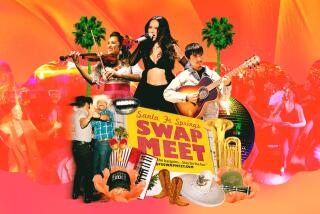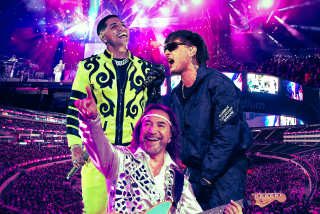Taking each note, making it theirs
Miguel Garcia has lived in Los Angeles for 16 years but until recently had never visited the Los Angeles County Museum of Art. The working-class immigrant and musician from Oaxaca had never even heard of the place. And neither had his two teenage sons, who play in a band led by their father, the LA Boyz.
Next week, the Garcias will become VIP visitors to the museum as stars of an unusual audio/video exhibit that’s part of a landmark Chicano art show titled “Phantom Sightings: Art After the Chicano Movement,” which opens April 6. The installation, called “Migrant Dubs,” takes the form of a 10-by-10 cube that visitors can enter and watch videos of the band in its home studio. The cube is meant to mimic the studio Garcia built in the converted garage behind the family’s bungalow in South L.A., not far from the infamous intersection of Florence and Normandie that marked the flash point of the L.A. riots of 1992, the year after he crossed the border illegally and settled here.
The sound cube is the brainchild of two artists who call themselves Los Jaichackers (Spanglish for hijackers), because they commandeer music to transform it. They are Julio Cesar Morales, 41, of San Francisco, and Eamon Ore-Giron, 34, of Los Angeles. By transplanting sounds from South L.A. to the Miracle Mile, the artists seek to show how people creatively navigate cultures in L.A.’s global environment.
“Essentially, it’s about the translation of culture when you come to California,” Morales says. “It’s not about adapting to the culture, but translating the culture and creating your own way to come to terms with it. In a way it’s how they negotiate being Latino, and at the same time being in this modern contemporary environment.”
The theory may be a little highfalutin for the kids, who play a crowd-pleasing repertoire of cumbias, salsa, merengue, ranchera, reggaeton and rock en espanol. The band is a family affair, like the Osmonds or the Jacksons, composed of Garcia’s sons, drummer Alan, 16, and keyboardist Elvis, 14, along with three cousins, guitarist Andy, 16, bassist Kevin, 14, and singer Fito, 13. Founded three years ago, the band has played for big crowds at Fiesta Broadway and for tips on weekends at Olvera Street.
That’s where they were discovered by Ore-Giron, who recruited them as the first in a series of artists to be featured in Migrant Dubs. As “Phantom Sightings” travels to different cities, including Mexico City, the artists plan to find other “underground” musicians and add their work like a growing playlist in a “video mix tape.”
The Chicano art exhibition is the museum’s first major group show to focus on Chicano art in two decades. “Phantom Sightings” spotlights a new generation of emerging artists who break from the standard traditions of Chicano painting and muralism to explore experimental, not necessarily ethnic concepts.
“Migrant Dubs” is smack in the middle of the massive show. For the LACMA debut, Los Jaichackers sent Garcia a CD with suggested songs the band could perform. And that’s where the concept hit the concrete. “My kids can’t transmit this kind of message, bro,” Garcia told the artists.
Los Jaichackers hadn’t counted on the evangelical fervor that fuels Garcia, 37, a convert from Catholicism. No way would let the LA Boyz perform what he considered lyrics that promoted drugs and sex in the electro-pop dance tune “Miedo” (Fear), by Mexico City’s Maria Daniela Y Su Sonido Lasser. Same goes for the surreal “Bathysphere” by Austin’s indie group Smog.
No problem, Los Jaichackers responded. Change the lyrics. Just keep the beats. So Garcia changed the lyrics of “Fear” to “El Lider,” with a wholesome message about avoiding bad friends and listening to your parents. He replaced the dreamy, ambiguous text of “Bathysphere” with “Latinos Unidos,” an ode to ethnic solidarity and immigrant perseverance. Unwittingly, the LA Boyz had validated the artistic concept by hijacking the songs and making them their own.
During installation this week, not all the LACMA curators were happy about the volume of the music rumbling out of the “Migrant Dubs” structure. From the outside, the cube sounded like those souped-up lowriders with the booming bass that annoy people as they cruise by.
The complaint about the noise was art imitating life. Garcia says he recently had to move his family from their Culver City duplex after a neighbor complained about the noise from their rehearsals. So he bought the bungalow on 68th Street, with iron bars on the windows and that soon-to-be-converted garage in the back.
The decor reflects the two forces in their lives -- music and religion. A piano dominates the small living room and the walls are covered with laminated religious posters. The Garcias kept their teenagers enrolled in their old schools on the Westside, partly out of concerns for their safety. Garcia makes a one-hour, round-trip commute every day, traversing the basin , to pick up his sons. On the way home one day this week, Elvis put on a gray coat to cover the red shirt he wore at school but which, back in the neighborhood, could be interpreted as a gang signal.
Garcia is protective and strict, especially about rehearsals. The kids sometimes would rather be skateboarding, but they get it. “You have to always be strict,” Alan says, “because if you’re not . . . “
“Kids won’t take you seriously,” Elvis finishes.
Garcia tells his boys they have to be serious about music, or it’s not worth doing. Music is all he’s ever cared about, even as a kid back home in Santa Ana del Valle, a Zapotec Indian community in Oaxaca. He comes from a long line of musicians and recalls scraping for money to buy instruments, sometimes selling the goats he was supposed to be tending, then lying that they wandered away. “We were just hungry to make music,” he says.
Garcia migrated when he was 20 and his oldest son was 4 months old. Garcia and his wife, Elia, have a third son. She’s a stay-home mom and he supports the family by giving music lessons, trading in used instruments, renting sound equipment and playing in his own band, Grupo Moderno, which performs every Friday at Sabor in Glendale.
Next week, the LA Boyz are scheduled to perform at a private reception for artists and the press at LACMA. Are they nervous?
“Not really,” Alan says. “I treat all the events the same way. We just try to have fun and put what we’ve got on the table.”
--
--
“Phantom Sightings: Art After the Chicano Movement,” April 6 through Sept. 1, Los Angeles County Museum of Art, 5905 Wilshire Blvd., Los Angeles. Call (323)857-6000 or visit www.lacma.org.
More to Read
Sign up for The Wild
We’ll help you find the best places to hike, bike and run, as well as the perfect silent spots for meditation and yoga.
You may occasionally receive promotional content from the Los Angeles Times.






